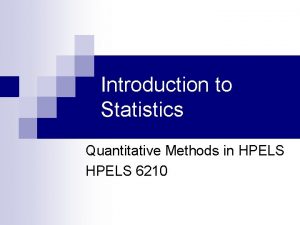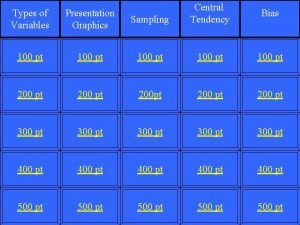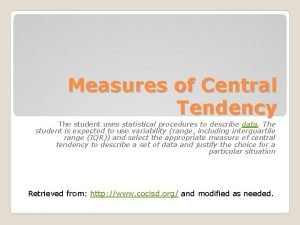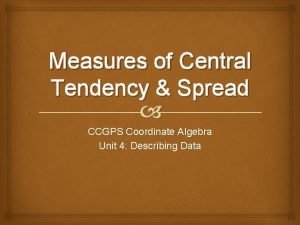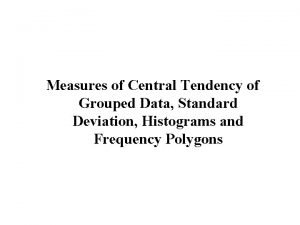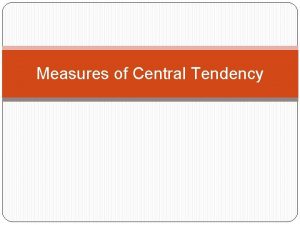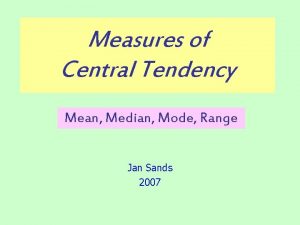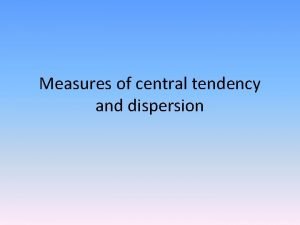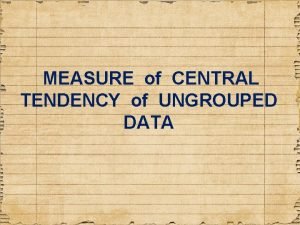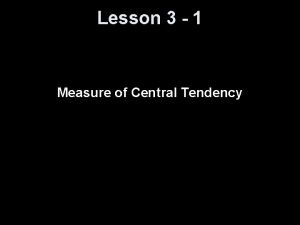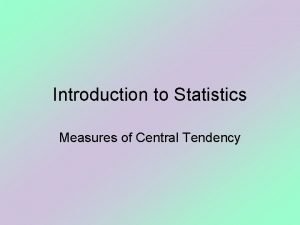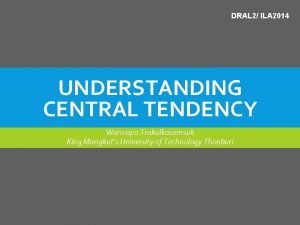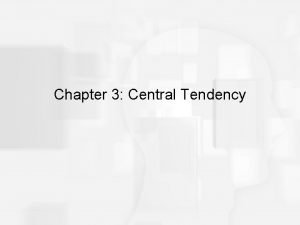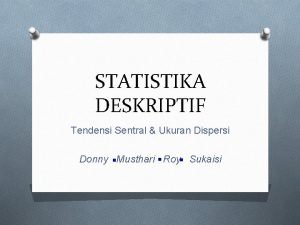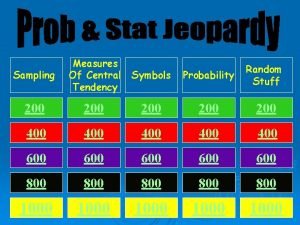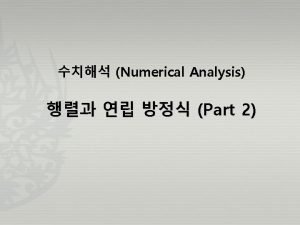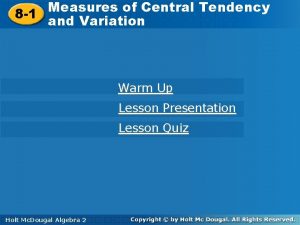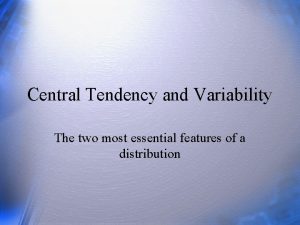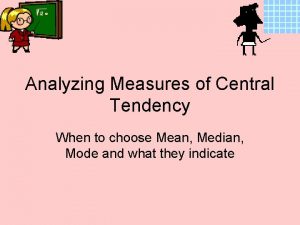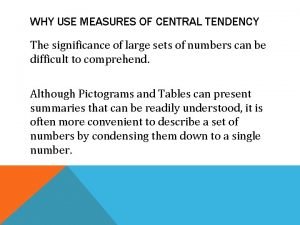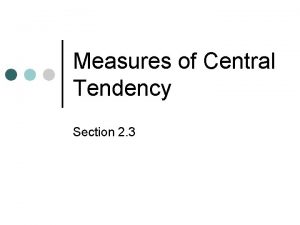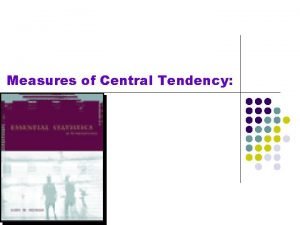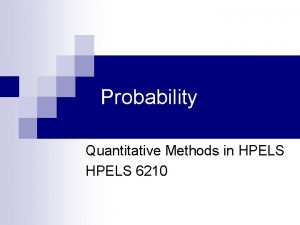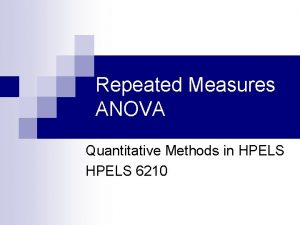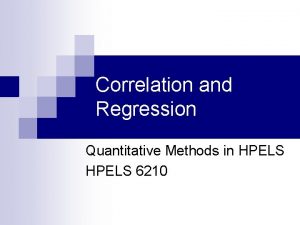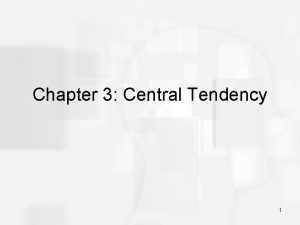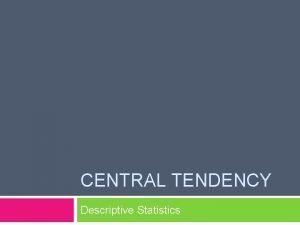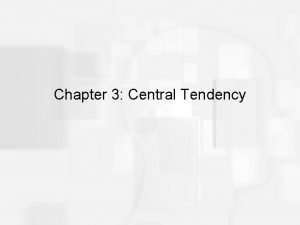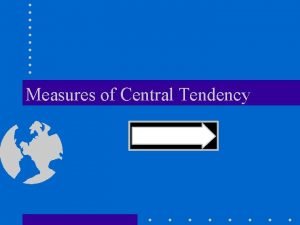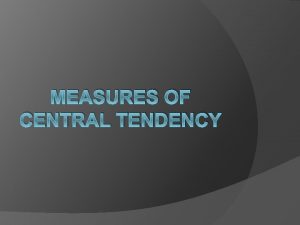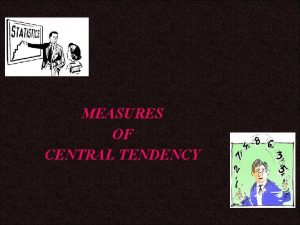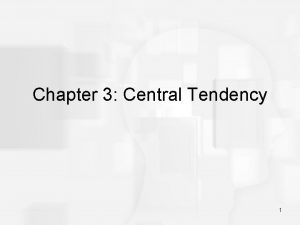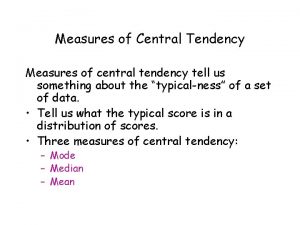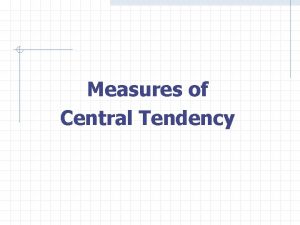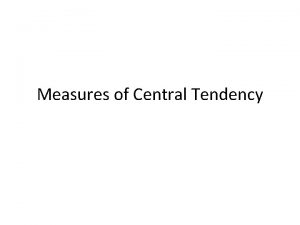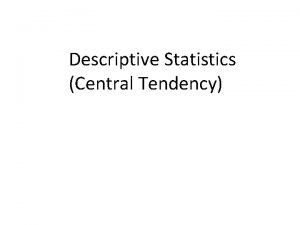Central Tendency Quantitative Methods in HPELS 6210 Agenda




























- Slides: 28

Central Tendency Quantitative Methods in HPELS 6210

Agenda Introduction n Mode n Median n Mean n Selection n

Introduction n Statistics of central tendency: ¨ Describe typical value within the distribution ¨ Describe the middle of the distribution ¨ Describe how values cluster around the middle of the distribution n Several statistics Appropriate measurement depends on: ¨ Scale of measurement ¨ Distribution


Introduction n The Three M’s: ¨ Mode ¨ Median ¨ Mean n Each statistic has its advantages and disadvantages

Agenda Introduction n Mode n Median n Mean n Selection n

Mode Definition: The score that occurs most frequently n Scale of measurement: n ¨ Appropriate for all scales ¨ Only statistic appropriate for nominal data n On a frequency distribution: ¨ Tallest portion of graph ¨ Category with greatest frequency

Central Tendency: Mode n Example: 2, 3, 4, 6, 7, 8, 8, 8, 9, 9, 10, 10 Mode?

Mode n Advantages ¨ Ease of determination ¨ Only statistic appropriate n for nominal data Disadvantages ¨ Unstable ¨ Terminal statistic ¨ Disregards majority of data ¨ Lack of precision (no decimals) ¨ There maybe more than one mode n Bimodal two n Multimodal > 2


Calculation of the Mode Instat Statistics tab n Summary tab n Group tab n ¨ Select “group” ¨ Select column of interest ¨ OK

Agenda Introduction n Mode n Median n Mean n Selection n

Median n n Definition: The score associated with the 50 th percentile Scale of measurement: ¨ Ordinal, n interval or ratio Methods of determination: ¨N n n = even List scores from low to high Median is the middle score = odd List scores from low to high Median = sum of two middle numbers / 2

Central Tendency: Median n Example 1: 1, 2, 3, 4, 5 n Example 2: 1, 2, 3, 4 Odd #: Median = middle number Even #: Median = middle two numbers / 2

Median n Advantages ¨ Ease of determination ¨ Effective with ordinal data ¨ Effective with skewed data n Not sensitive to extreme outliers n Examples: Housing costs n Disadvantages: ¨ Terminal statistic ¨ Not appropriate for nominal ¨ Disregards majority of data ¨ Lack of precision data

Calculation of the Median Instat Statistics tab n Summary tab n Describe tab n ¨ Choose “additional statistics” ¨ Choose “median” ¨ OK

Agenda Introduction n Mode n Median n Mean n Selection n

Mean Definition: Arithmetic average n Most common measure of central tendency n Scale of measurement: n ¨ Interval n or ratio Statistical notation: “myoo” ¨ Sample: x-bar or M ¨ Population:

Mean n Method of determination: ¨ = ΣX/N ¨ X-bar n or M = ΣX/n Advantages: ¨ Sensitive to all values ¨ Considers all data ¨ Not a terminal statistic ¨ Precision (decimals) n Disadvantages: ¨ Not appropriate with nominal or ordinal data ¨ Sensitive to extreme outliers

Calculation of the Mean Instat Same as median n Mean is calculated automatically n

Agenda Introduction n Mode n Median n Mean n Selection n

When to Use the Mode Appropriate for all scales of measurement n Use the mode with nominal data n

When to Use the Median n Appropriate with ordinal, interval and ratio data ¨ Especially effective with ordinal data DO NOT use with nominal data n Use the median with skewed data n


When to Use the Median n Use the median with undetermined values

When to Use the Median n Use the median with open-ended distributions

When to Use the Mean Use the mean with interval or ratio data n Use the mean when the distribution is normal or near normal n

Textbook Problem Assignment n Problems: 2, 4, 6, 8, 12, 16, 22.
 Hpels
Hpels Central tendency bias
Central tendency bias Measures of central tendency
Measures of central tendency Central tendency and spread homework
Central tendency and spread homework Ungrouped data
Ungrouped data Objective of central tendency
Objective of central tendency Mode of grouped data
Mode of grouped data Measures of central tendency range
Measures of central tendency range Central tendency and dispersion
Central tendency and dispersion Central tendency of ungrouped data
Central tendency of ungrouped data Measures of central tendency median
Measures of central tendency median Measures of central tendency
Measures of central tendency Measures of central tendency
Measures of central tendency Statistics mean median mode grouped data formula
Statistics mean median mode grouped data formula Use of central tendency
Use of central tendency Central tendency
Central tendency How to do mean median mode range
How to do mean median mode range Modus
Modus Ukuran kecenderungan sentral dan variabilitas
Ukuran kecenderungan sentral dan variabilitas Measures of central tendency symbols
Measures of central tendency symbols Central tendency in performance appraisal
Central tendency in performance appraisal Nxn 역행렬 알고리즘
Nxn 역행렬 알고리즘 Measures of central tendency and variation
Measures of central tendency and variation Central tendency and variability
Central tendency and variability Measures of central tendency worksheet
Measures of central tendency worksheet Why is the median useful
Why is the median useful Rumus modus
Rumus modus Central tendency symbols
Central tendency symbols Central tendency
Central tendency
